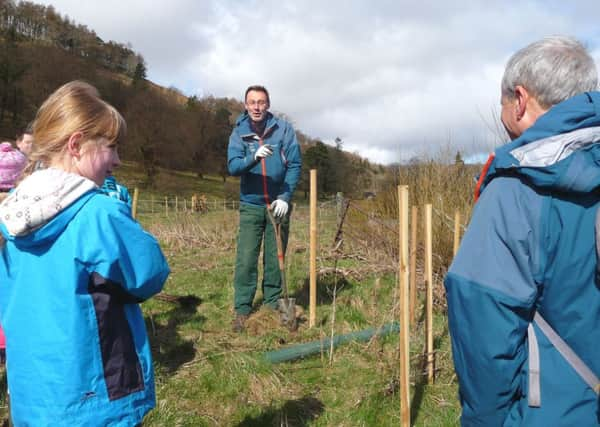Dig in for outdoor satisfaction


Volunteering to plant trees in the countryside might be a worthy thing to do but I wasn’t expecting this sort of recognition.
We were gathering in the car park at Buckden, Upper Wharfedale ready for action. The Sunday morning work party ended up more than 20-strong – a mix of local residents and National Trust staff and their children, no doubt hauled from their beds early with the promise of ‘a day in the country’. But if they’d been initially reluctant they soon gained a spring in their step as we wandered down the riverside to begin our work.
Advertisement
Hide AdAdvertisement
Hide AdOur task was to plant trees along the Wharfe under the guidance of ranger Peter Katic and ecologist and wildlife engagement officer Peter Welsh. First, ecologist Peter explained that the condition of the riverside Site of Special Scientific Interest we were standing in was officially classed as unfavourable. “Work is needed,” he said in an ominous tone.
A strip of land next to the river had recently been fenced off with the aim of developing an area of scrubby growth behind it, away from the attentions of hungry cattle and sheep. This was where we were to plant our trees, mainly willow and alder, to help make the riverbank more resilient in times of flood and a better habitat for wildlife.
“It’s all part of a long-term plan in partnership with farmers,” our ecologist told us. “We want to allow the river more room to move and fluctuate. We’re never going to get things to return to a truly natural state but we can create an area of more natural grassland and wet woodland alongside it.”
Turning, he caught the expressions on the faces of two of the children. “This is a bit boring for you, isn’t it,” he observed graciously. “Well, what we’re going to do today is make things prettier and better for the birds and the otters. And even the fish too, because they like some shade.”
Advertisement
Hide AdAdvertisement
Hide AdA flicker of life returned to the young faces and it grew when ranger Peter handed out spades. He then demonstrated the best way to plant a tree. After 30 years with the National Trust, he should have it mastered by now. After a few brisk thrusts with his spade and some tender packing of soil around a knee-high sapling, he carefully lowered a weather-guard over the young tree and secured it to a sturdy post. Job done.
Splitting into small groups, we warmed to the task. The Scott family from Buckden was no exception. Rebecca, eight, Emily, six, Madeleine, five, and even James, three, soon got the hang of it. Later, their father Mark would tell me: “The children really enjoyed themselves. We’ve also been planting some trees in our garden at home and the older children are well aware of environmental issues through school.”
Ranger Peter explained that satisfaction was one of the big paybacks for people who volunteer for conservation work: “If you’re tree planting, then you’re leaving your mark on the landscape. Your trees are going to be there for a long time. Dry-stone walling is very popular too. The end result can give you a lot of pleasure but just being outside in the open is uplifting. Being physically active in this way is more fun than going to the gym for some and often you get to see places away from normal public access.”
By lunchtime our large bag of young trees was empty. Even so, I couldn’t help thinking that, as a raw volunteer, I couldn’t hope to match the output of a professional but Peter Katic was adamant that volunteers are hugely important: “The National Trust was set up by volunteers and volunteering is very much at its centre. Work would simply not get done without it. But we don’t just see volunteers as a workforce, we like to help people build up experience and new skills – particularly important for those wanting to move into this area of work full-time.”
Advertisement
Hide AdAdvertisement
Hide AdMany of us might harbour a desire to follow the heart into meaningful conservation work but it often remains a vague plan B. Volunteering for a few hours at the weekend is a realistic half-way house.
How to volunteer
* National Trust: Dry-stone walling, maintain paths and fences, manage woodland, tree planting and habitat surveys. Visit www.nationaltrust.org.uk/get-involved/volunteer
* Yorkshire Dales Millennium Trust: Collect and sow wild flowers, maintain woodland and bee surveys. Visit www.ydmt.org
* RSPB: Assess biodiversity, manage habitats, monitor birds and survey seashores. Visit www.rspb.org.uk/volunteering
* Yorkshire Wildlife Trust: Check livestock, clean beaches, clear scrub, coppicing, monitor water voles and more. Visit www.ywt.org.uk/volunteer